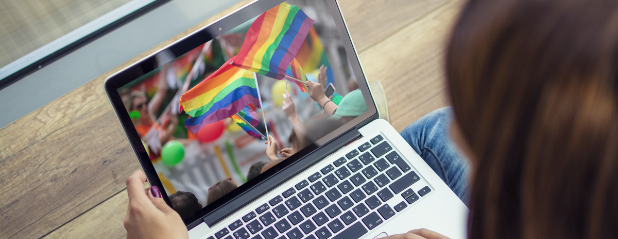5 ways the tech industry has made a positive impact on the LGBTQ+ community

As we come to the end of Pride Month, we reflect on just how far the LGBTQ+ community has come and how much work has been done to help people within the community feel empowered. LGBTQ+ individuals can now connect in ways that weren't possible 20 years ago thanks to the internet, social media, and online content creation. We’ve put together just a few of the ways technology is helping to harness the community.
1. Creating a safe space online
Whilst the internet can sometimes pose a threat to the LGBTQ+ community with regard to online bullying, it can also function as a place of comfort. Some individuals who may feel alienated from families and friends can seek help and support from online groups
There are multiple charities and services online including MindOut, Stonewall, LGBTQ Foundation, and many more, that offer advice, support, and forums for anyone who seeks it. 30 years ago, there would not have been any online ‘safe space’ for the LGBTQ+ community.
With the use of social media and various apps the LGBTQ+ community can now interact online safely without fear of cyberbullying and threats. For example, there are separate groups people can join, including Facebook’s very own LBGTQ@Facebook group, a place that offers a safe environment where people can be their authentic selves.
2. Diversity and Inclusivity
According to diversityintech.co.uk a study from the Institution of Engineering and Technology (IET) found that a third of LGBTQ people avoid careers in science, technology, and engineering due to worries of discrimination and bullying.
It is now up to companies to show support to LGBTQ employees, making sure they are uplifted and treated as a valued member of the office community regardless of how they identify. Many companies including Lloyds have created LGBTQ+ networks, that include creating content online, showing their commitment to providing a safe and supportive working environment.
3. Representation
Representation can be shown in multiple ways and can be empowering to those who might not be as confident with their gender identity and sexual orientation. For example, in 2014 the CEO of Apple, Tim Cook decided to come out as gay after reading letters from children who were struggling with their identity. Tim Cook’s decision to declare himself a member of the LGBTQ+ community shows individuals that sexual orientation is not an obstacle to a successful career.
Apple also highlighted its commitment to the community by releasing new emojis. Including the pride flag, the transgender flag, and gender-neutral avatar options. Something as simple as an emoji can help the community to feel seen and accepted.
4. Discovery of Identity
The internet offers a lot of ‘safe space’ forums and groups for the LGBTQ+ community, it also offers a lot of content and resources. According to thinkuknow.co.uk, 96% of LGBT young people say the internet has helped them understand more about their sexual orientation and/or gender identity.
Today’s generation has access to a wealth of information online, from educating blog posts and vlogs on YouTube of other people sharing their personal experiences, in turn giving others confidence and an opportunity to connect with other LGBTQ+ users and validate their experiences.
5. Use of VPNs
A Virtual Provider Network (VPN) establishes a secure, encrypted connection between your computer and the internet. It is a tool that helps protect your data and helps you to stay private online. The use of a VPN is particularly important for LGBTQ people who aren't open about their sexuality. They might not have told their family and friends yet, or maybe they live in one of the 70 countries where homosexuality is still illegal. Not using a VPN puts your personal details at risk.
For anyone who wants to access LGBTQ-related content online without leaving a digital trail, a VPN would be extremely useful.
The impact that technology has had on the LGBTQ+ community is huge, and hopefully, this is only the start of showing how it can be used to help make a positive impact.
